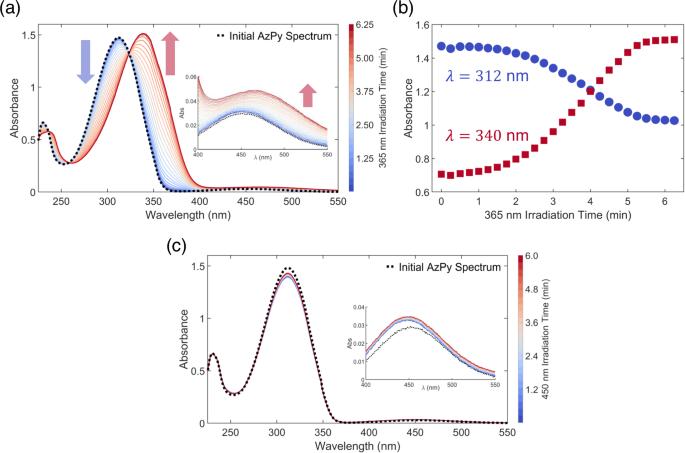最终解释了二氯甲烷中基本偶氮光开关的警示故事。
IF 5.9
2区 化学
Q1 CHEMISTRY, MULTIDISCIPLINARY
引用次数: 0
摘要
许多关于偶氮苯光开关的研究都是在极性钝化溶剂中进行的,作为热异构化的第一原理表征。其中最方便的极性钝化溶剂是氯化碳氢化合物,如二氯甲烷。然而,在此类溶剂中进行偶氮苯热异构化研究时,即使进行了严格的清洁和干燥处理,也会出现虚假、不确定和不可再现的结果,这一现象尚未得到很好的理解。我们介绍了对这一问题的根本原因进行全面调查的结果。我们解释了在二氯甲烷中用紫外线照射偶氮吡啶光开关如何不仅触发光异构化,而且通过溶剂的光分解使吡啶分子质子化。质子化明显加快了热异构化速率,DFT 计算表明,许多偶氮光开关假定的单色-三色旋转机制竟然被取消了。这项研究揭示了光解产生质子的优势,并最终解释了在异构化实验中禁止在紫外线照射下使用氯化溶剂的警告。本文章由计算机程序翻译,如有差异,请以英文原文为准。

A cautionary tale of basic azo photoswitching in dichloromethane finally explained
Many studies of azobenzene photoswitches are carried out in polar aprotic solvents as a first principles characterization of thermal isomerization. Among the most convenient polar aprotic solvents are chlorinated hydrocarbons, such as DCM. However, studies of azobenzene thermal isomerization in such solvents have led to spurious, inconclusive, and irreproducible results, even when scrupulously cleaned and dried, a phenomenon not well understood. We present the results of a comprehensive investigation into the root cause of this problem. We explain how irradiation of an azopyridine photoswitch with UV in DCM acts not just as a trigger for photoisomerization, but protonation of the pyridine moiety through photodecomposition of the solvent. Protonation markedly accelerates the thermal isomerization rate, and DFT calculations demonstrate that the singlet-triplet rotation mechanism assumed for many azo photoswitches is surprisingly abolished. This study implies exploitative advantages of photolytically-generated protons and finally explains the warning against using chlorinated solvent with UV irradiation in isomerization experiments. Azobenzenes undergo reversible light-induced photoisomerization, resulting in marked spectroscopic, electronic, and mechanical changes, but their sensitivity towards solvents is not fully understood. Here, the authors report how irradiation of an azopyridine photoswitch with UV light in dichloromethane triggers protonation of the pyridine moiety through photodecomposition of the solvent, consequently accelerating thermal back isomerization and abolishing singlet-triplet rotation mechanisms.
求助全文
通过发布文献求助,成功后即可免费获取论文全文。
去求助
来源期刊

Communications Chemistry
Chemistry-General Chemistry
CiteScore
7.70
自引率
1.70%
发文量
146
审稿时长
13 weeks
期刊介绍:
Communications Chemistry is an open access journal from Nature Research publishing high-quality research, reviews and commentary in all areas of the chemical sciences. Research papers published by the journal represent significant advances bringing new chemical insight to a specialized area of research. We also aim to provide a community forum for issues of importance to all chemists, regardless of sub-discipline.
 求助内容:
求助内容: 应助结果提醒方式:
应助结果提醒方式:


